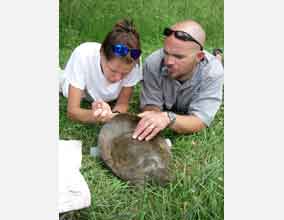Multimedia Gallery
Physiology and Behavior Study (Image 14)
Bill Hopkins, associate professor of fisheries and wildlife science at Virginia Tech, instructs a student on how to take blood samples from a soft-shell turtle. Hopkins and colleagues are conducting studies to determine how the physiology and behavior of female amphibians, turtles and birds affect their offspring, and the consequences these interactions may have for population health. [Image 14 of 14 related images. Back to Image 1.] (Date of Image: 2009)
More about this Image
Bill Hopkins and his VA Tech research team are studying the effects of environmental pollution on birds, amphibians and turtles. Like other egg-laying species, female amphibians pass nutrients, hormones and energy to their eggs to support their development. However, they can also pass along toxins that have accumulated in their tissue, like mercury.
Christine Bergeron is a doctoral student in fisheries and wildlife sciences who is working on her doctoral research with Hopkins, studying the affects of maternal transfer of mercury to early embryos, larva and juveniles, and how this may affect the local population health. Bergeron's study subjects are American toads.
Breeding pairs are collected and taken to their field lab, where they reproduce under controlled conditions. Eggs are collected immediately after they're laid, and adults are returned to their habitat.
Hopkins and Bergeron are working in collaboration with researchers from the University of Kentucky, who perform a number of descriptive bioassay and experimental tests to determine how much mercury and other contaminants was transferred to the eggs, and whether or not the offspring will experience any adverse affects as a result.
Using data from past field seasons, the team has confirmed that female toads do indeed transfer mercury to their eggs. "Even though females pass only a small percentage of the mercury in their bodies to their eggs, we observed lower hatching success from the egg clutches with the highest mercury concentrations," said Bergeron. "Our next step is to determine if the mercury passed from the mother affects the hatchlings later in life, especially as they undergo metamorphosis [the transition of a tadpole into a toad]. These measurements are important because they may indicate how well toads do once they enter the terrestrial environment."
Mercury is a major pollutant in the state of Virginia, so Hopkins' research is very important. With their permeable skin and complex life-cycles, toads and other amphibians are considered natural indicators of ecosystem health. They are among the first species affected when contaminants are introduced to an ecosystem, and can be used to identify threats to other components of polluted environments.
Hopkins' lab is also looking at the interaction between pollution and parasitism--the bioenergetics of threatened species--and stress physiology. He aims to use modern physiological tools to provide scientific results that contribute to the conservation of healthy wildlife populations. To learn more about these and other projects in the Hopkins' lab, visit the lab website Here.
Credit: Photo by Josh McCormick-Goodheart; courtesy Bill Hopkins, Virginia Tech
Images and other media in the National Science Foundation Multimedia Gallery are available for use in print and electronic material by NSF employees, members of the media, university staff, teachers and the general public. All media in the gallery are intended for personal, educational and nonprofit/non-commercial use only.
Images credited to the National Science Foundation, a federal agency, are in the public domain. The images were created by employees of the United States Government as part of their official duties or prepared by contractors as "works for hire" for NSF. You may freely use NSF-credited images and, at your discretion, credit NSF with a "Courtesy: National Science Foundation" notation.
Additional information about general usage can be found in Conditions.
Also Available:
Download the high-resolution JPG version of the image. (2.8 MB)
Use your mouse to right-click (Mac users may need to Ctrl-click) the link above and choose the option that will save the file or target to your computer.

